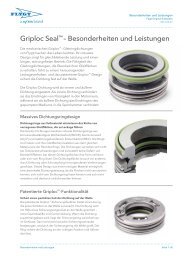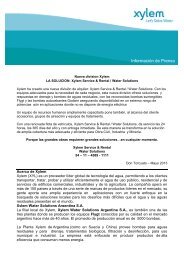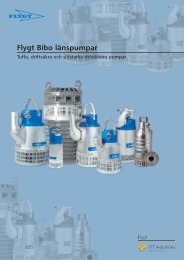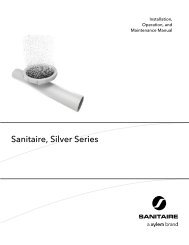ITT's Place in the Cycle of Water - Water Solutions
ITT's Place in the Cycle of Water - Water Solutions
ITT's Place in the Cycle of Water - Water Solutions
You also want an ePaper? Increase the reach of your titles
YUMPU automatically turns print PDFs into web optimized ePapers that Google loves.
<strong>Water</strong> Worries<strong>Water</strong> Recycl<strong>in</strong>g and ReuseOnce water is used by <strong>in</strong>dustry (for a variety <strong>of</strong>purposes, <strong>in</strong>clud<strong>in</strong>g clean<strong>in</strong>g, heat<strong>in</strong>g, and cool<strong>in</strong>g), <strong>the</strong>result<strong>in</strong>g liquid wastes require specialized treatment,<strong>in</strong> contrast to <strong>the</strong> relatively straightforward treatment<strong>of</strong> wastewater from residential sources. In anenvironment where <strong>the</strong> supply <strong>of</strong> water is <strong>in</strong>creas<strong>in</strong>glyan issue, a greater emphasis will likely be placed onwater recycl<strong>in</strong>g and reuse:• <strong>Water</strong> recycl<strong>in</strong>g normally <strong>in</strong>volves only one user,with <strong>the</strong> effluent from <strong>the</strong> user be<strong>in</strong>g captured andredirected back <strong>in</strong>to <strong>the</strong> activity.• <strong>Water</strong> reuse is <strong>the</strong> use <strong>of</strong> treated wastewater forbeneficial purposes, such as agricultural irrigationand <strong>in</strong>dustrial cool<strong>in</strong>g.Public-Private PartnershipsEven if water is consumed efficiently and wastewateris recycled, it is still <strong>the</strong> case that, <strong>in</strong> many parts <strong>of</strong> <strong>the</strong>world, a significant percentage <strong>of</strong> distributed waternever reaches <strong>the</strong> f<strong>in</strong>al user because <strong>of</strong> leakageSuch problems are most acute <strong>in</strong> long-establishedurban areas with ag<strong>in</strong>g <strong>in</strong>frastructures. Dr<strong>in</strong>k<strong>in</strong>g waterpipes can be expected to last between 50 and 100years (depend<strong>in</strong>g on <strong>the</strong>ir quality, <strong>the</strong> type <strong>of</strong> ground<strong>the</strong>y are laid <strong>in</strong>, and climate conditions), which meansthat 1% to 2% <strong>of</strong> <strong>the</strong> network must be replaced everyyear. In developed countries, <strong>in</strong>clud<strong>in</strong>g <strong>the</strong> U.S., mosturban pipe networks were laid at <strong>the</strong> beg<strong>in</strong>n<strong>in</strong>g <strong>of</strong> <strong>the</strong>twentieth century, but replacement work has <strong>of</strong>tenbeen neglected.ITT’s <strong>Place</strong> In The <strong>Cycle</strong> <strong>of</strong> <strong>Water</strong>: Everyth<strong>in</strong>g But The Pipes

















